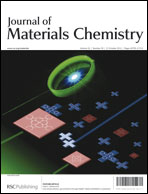Temperature-responsive porous polycaprolactone-based films via surface-initiated ATRP for protein delivery
Abstract
The inherent hydroxyl groups on the porous polycaprolactone (PPCL) films (prepared by using poly(ethylene glycol) as the pore-forming agent) could be reacted with 2-bromoisobutyrate bromide to produce a sufficient concentration of surface-coupled atom transfer


 Please wait while we load your content...
Please wait while we load your content...